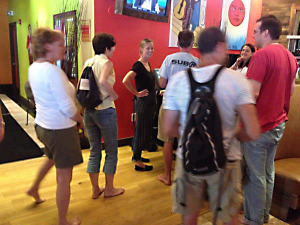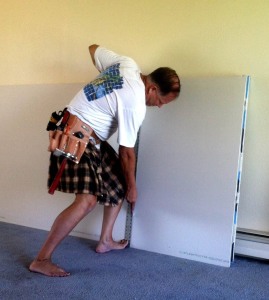 Have you ever heard the claim that “Shoes are required” due to Health Department or OSHA regulations?
Have you ever heard the claim that “Shoes are required” due to Health Department or OSHA regulations?
In virtually all cases–that’s simply not true!
Below, we address each item separately, beginning with the Health Dept. claim.
HEALTH DEPARTMENT CODES and Bare Feet
If you live in the U.S., perhaps you have SEEN THIS SIGN in a store or restaurant:
DO NOT BELIEVE OR ACCEPT IT!
It’s a myth (ahem . . . an outright “lie”).
State Health Department codes do not regulate customer clothing–including footwear.
Want proof? Just search for any state’s health code (see below) and you can see for yourself. Hint: they say nothing about it.
How about written documentation? See the letters below (in Adobe PDF format, ready to print and carry for easy reference). All confirm that no state health department (or agriculture dept.) regulation requires footwear for customers anywhere–including stores and restaurants. [See history of letters below.]
Note: Local health departments throughout the U.S., as a rule, follow their state’s health regulations. Rarely, local departments may add regulations, but we know of only a very few regarding footwear–and oddly these all occur in a few small localities in Massachusetts.
Want to see EACH STATE’S HEALTH CODE for yourself? Click here for the FDA website that provides direct links.
HISTORY OF THE LETTERS: In 1997, several SBL members first wrote to U.S. state health departments (or agriculture depts.) for confirmation letters. In 2002, in 2009 and again in 2017 we repeated the project to update responses from all 50 U.S. states. UPDATE: Some letters have more recent dates (even as recent as 2024), as we continue to individually request and receive updates. Point to recognize: nothing has changed! Health Dept.s don’t regulate customer footwear.
FDA Food Code – The U.S. Government Food and Drug Admin Food Code homepage (spoiler: nothing about customers and bare feet). As the website states, the FDA publishes the Food Code, a model that assists food control jurisdictions at all levels of government for regulating the retail and food service segment of the industry, including restaurants and grocery stores.
========
Wondering about CANADA REGULATIONS?
- Alberta: View letter from the Health Services in Alberta, Canada.
What about U.K. REGULATIONS?
- View a letter from the Health and Safety Executive (HSE) in the United Kingdom confirming that the U.K. has no codes regulating customer footwear in establishments.
- A UK article reporting on a Health & Safety Executive finding that no UK legislation exists preventing barefooted customers from entering a shop.
Other EUROPEAN REGULATIONS?
- SPAIN: To see an email from the Spanish Ministry of Health, click here for the original Spanish, and here for an English translation.
___________________________________________________
LEGAL MATTERS
- A NOTE ON “RIGHTS OF REFUSAL”: A business may set its own dress code if it wishes, but no established health code requires (or even suggests) any need for that. For helpful insights on this aspect of law, see: LegalMatch: “Restaurants: Right to Refuse Service”
- WHAT ABOUT LIABILITY? An article reviewing contributory negligence and comparative fault laws in all 50 states (U.S.) [Another article on this subject]
- WHAT IS “DUTY OF CARE”? Two helpful resources: a) A legal article explaining the liability limits and responsibilities of establishments. b) Another legal article
- RELIGIOUS GARB IN THE WORKPLACE: RIGHTS AND RESPONSIBILITIES – This U.S. Equal Employment Opportunity Commission (EEOC) web page addresses U.S. law related to dress and grooming in the workplace. It deals with employee matters, but the principles seem relevant to anyone who chooses to go barefoot for religious reasons.
- WHAT ABOUT PUBLIC TRANSPORTATION RULES? – This letter from the U.S. Dept of Transportation (Federal Transit Admin.–FTA) confirms that NO Federal regulation requires footwear or prohibits bare feet for passengers.
- WHAT ABOUT STORE POLICIES? – WALMART – This document from Walmart corporate headquarters confirms that Walmart does not require footwear for customers. Another confirmation from Walmart.
___________________________________________________
ORIGIN OF “SHOES REQUIRED” SIGNS
Where did “Shirt and Shoes Required” Come From?
by David Roos, in HowStuffWorks (updated April 13, 2021)
Where did “No Shirt, No Shoes, No service” come from?
A great article in Sporcle Blog that explores the sources of this unfortunate policy (December, 2019)
“No Shirt, No Shoes, No service“: where did it come from?
Article in blog, Lets Go Barefoot (Dec. 2014)
‘No bare feet’ signs are similar to the racist signs of the past
Article in Blog, Born To Live Barefoot by Kriss Sands, (August, 2019)
OSHA and Bare Feet
QUESTION #1: Do OSHA (Occupational Safety and Health Administration) regulations (in the U.S.) require customers in businesses, including stores and restaurants, to wear some kind of footwear?
 ANSWER: No! OSHA regulations apply only to employees, not customers. But even for employees, OSHA requires footwear only in special circumstances-and then it must specify the standards and criteria. In many cases, OSHA regulations do not require footwear for employees.
ANSWER: No! OSHA regulations apply only to employees, not customers. But even for employees, OSHA requires footwear only in special circumstances-and then it must specify the standards and criteria. In many cases, OSHA regulations do not require footwear for employees.
* * * * * * * * * * * * * * * * * * * * *
QUESTION #2: When does OSHA require footwear for employees?
ANSWER: The following OSHA regulations make reference to footwear:
1910.94 – Ventilation
(a)(5)(v) Safety shoes shall be worn to protect against foot injury where heavy pieces of work are handled. Safety shoes shall conform to the requirements of American National Standard for Men’s Safety-Toe Footwear, Z41.1-1967, which is incorporated by reference as specified in Sec. 1910.6.
1910.136 – Occupational foot protection
(a) General requirements. The employer shall ensure that each affected employee uses protective footwear when working in areas where there is a danger of foot injuries due to falling or rolling objects, or objects piercing the sole, and where such employee’s feet are exposed to electrical hazards.
(b) Criteria for protective footwear.
(1) Protective footwear purchased after July 5, 1994 shall comply with ANSI Z41-1991, “American National Standard for Personal Protection-Protective Footwear,” which is incorporated by reference as specified in Sec. 1910.6, or shall be demonstrated by the employer to be equally effective.
(2) Protective footwear purchased before July 5, 1994 shall comply with the ANSI standard “USA Standard for Men’s Safety-Toe Footwear,” Z41.1-1967, which is incorporated by reference as specified in Sec. 1910.6, or shall be demonstrated by the employer to be equally effective.
1910.156 Fire brigades
(ii) The employer shall assure that protective clothing protects the head, body, and extremities, and consists of at least the following components: foot and leg protection; hand protection; body protection; eye, face and head protection.
(2) Foot and leg protection.
(i) Foot and leg protection shall meet the requirements of paragraphs (e)(2)(ii) and (e)(2)(iii) of this section, and may be achieved by either of the following methods:
(A) Fully extended boots which provide protection for the legs; or
(B) Protective shoes or boots worn in combination with protective trousers that meet the requirements of paragraph (e)(3) of this section.
(ii) Protective footwear shall meet the requirements of 1910.136 for Class 75 footwear. In addition, protective footwear shall be water-resistant for at least 5 inches (12.7 cm) above the bottom of the heel and shall be equipped with slip-resistant outer soles.
(iii) Protective footwear shall be tested in accordance with paragraph (1) of Appendix E, and shall provide protection against penetration of the midsole by a size 8D common nail when at least 300 pounds (1330 N) of static force is applied to the nail.
1910.269 – Electric Power Generation, Transmission, and Distribution
(3) “Sprayers and related equipment.”
(i) Walking and working surfaces of sprayers and related equipment shall be covered with slip-resistant material. If slipping hazards cannot be eliminated, slip-resistant footwear or handrails and stair rails meeting the requirements of Subpart D may be used instead of slip-resistant material.
1910.1029 – Coke oven emissions
(h) Protective clothing and equipment – (1) Provision and use. The employer shall provide and assure the use of appropriate protective clothing and equipment, such as but not limited to:…
{iv} Footwear providing insulation from hot surfaces for footwear;
{v} Safety shoes which comply with 1910.136 of this part;
1915.35 – Painting
(b)(7)(9) The face, eyes, head, hands, and all other exposed parts of the bodies of employees handling such highly volatile paints shall be protected. All footwear shall be non-sparking, such as rubbers, rubber boots or rubber soled shoes without nails.
1915.156 – Foot protection
(a) Use. The employer shall ensure that each affected employee wears protective footwear when working in areas where there is a danger of foot injuries due to falling or rolling objects or objects piercing the sole.
(b) Criteria for protective footwear.
(1) Protective footwear purchased after August 22, 1996 shall comply with ANSI Z41-1991, “American National Standard for Personal Protection-Protective Footwear,” which is incorporated by reference, as specified in Sec. 1915.5, or shall be demonstrated by the employer to be equally as effective.
(2) Protective footwear purchased before August 22, 1996 shall comply with the “American National Standard for Personal Protection-Protective Footwear Z41-1983,” which is incorporated by reference, as specified in Sec. 1915.5, or shall be demonstrated by the employer to be equally effective.
1917.94 – Foot protection
(a) The employer shall direct that employees exposed to impact, falling objects, or puncture hazards wear safety shoes, or equivalent protection.
(b) Protective shoes shall bear identifying marks or labels indicating compliance with the manufacturing provisions of American National Standard for Men’s Safety Toe Footwear, ANSI Z41.1-1967.


